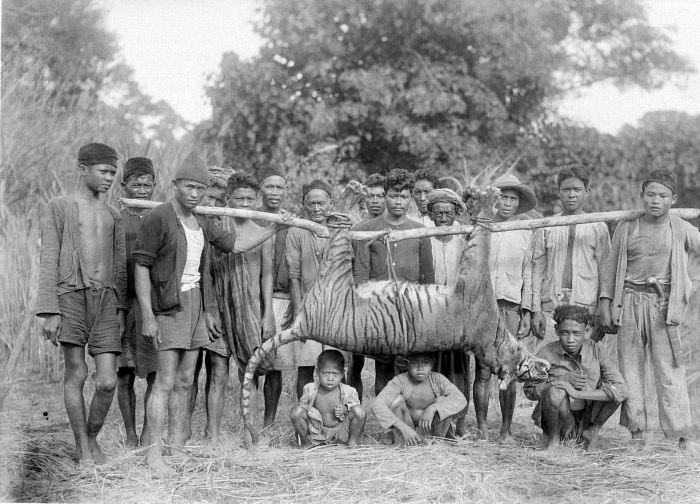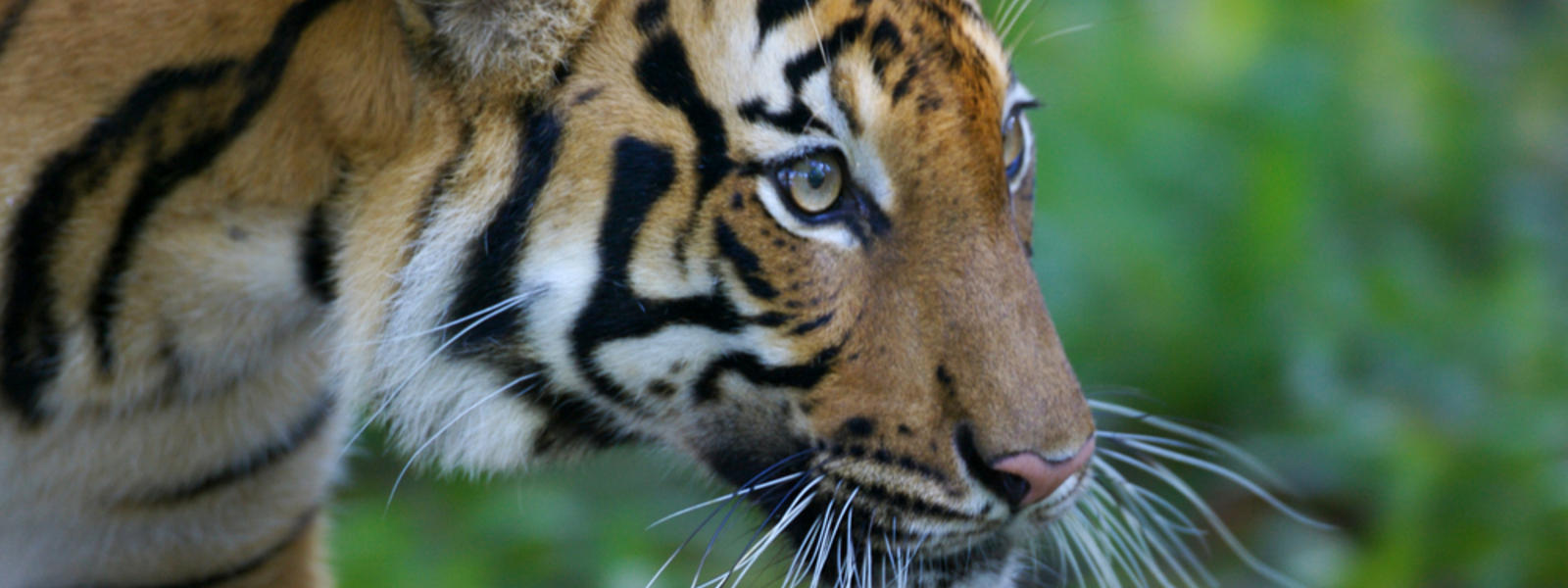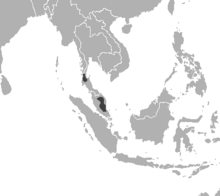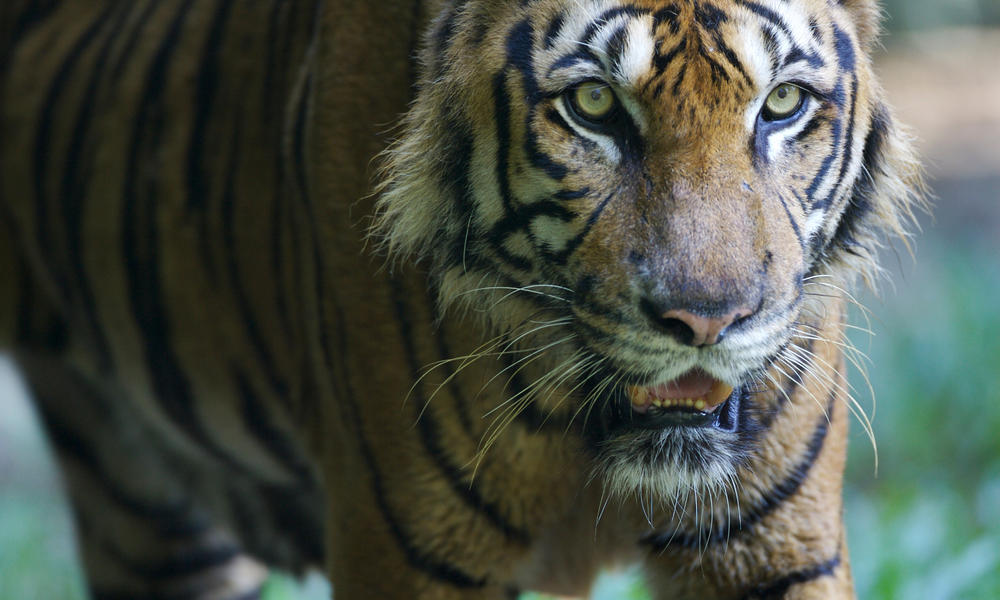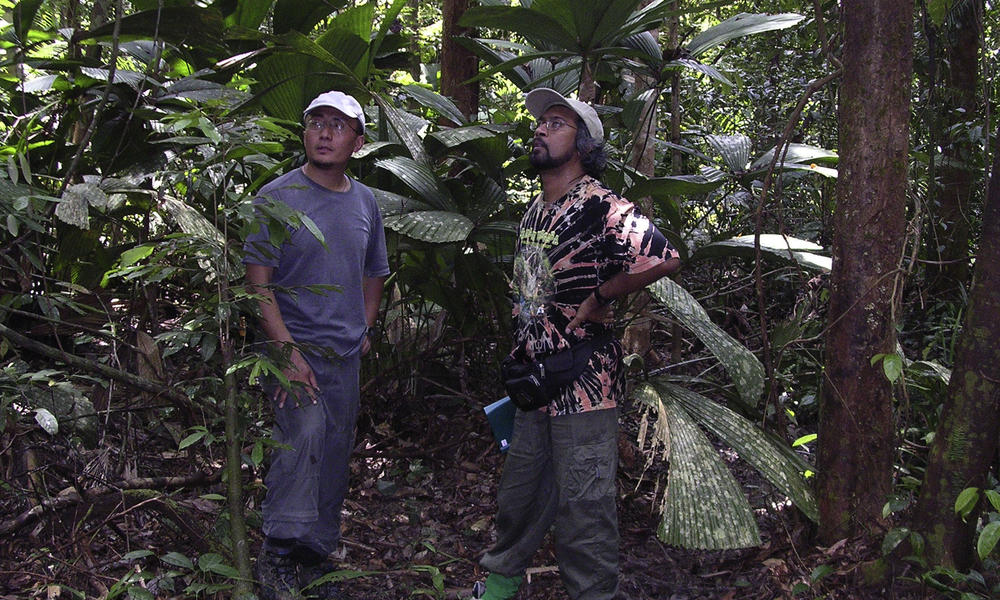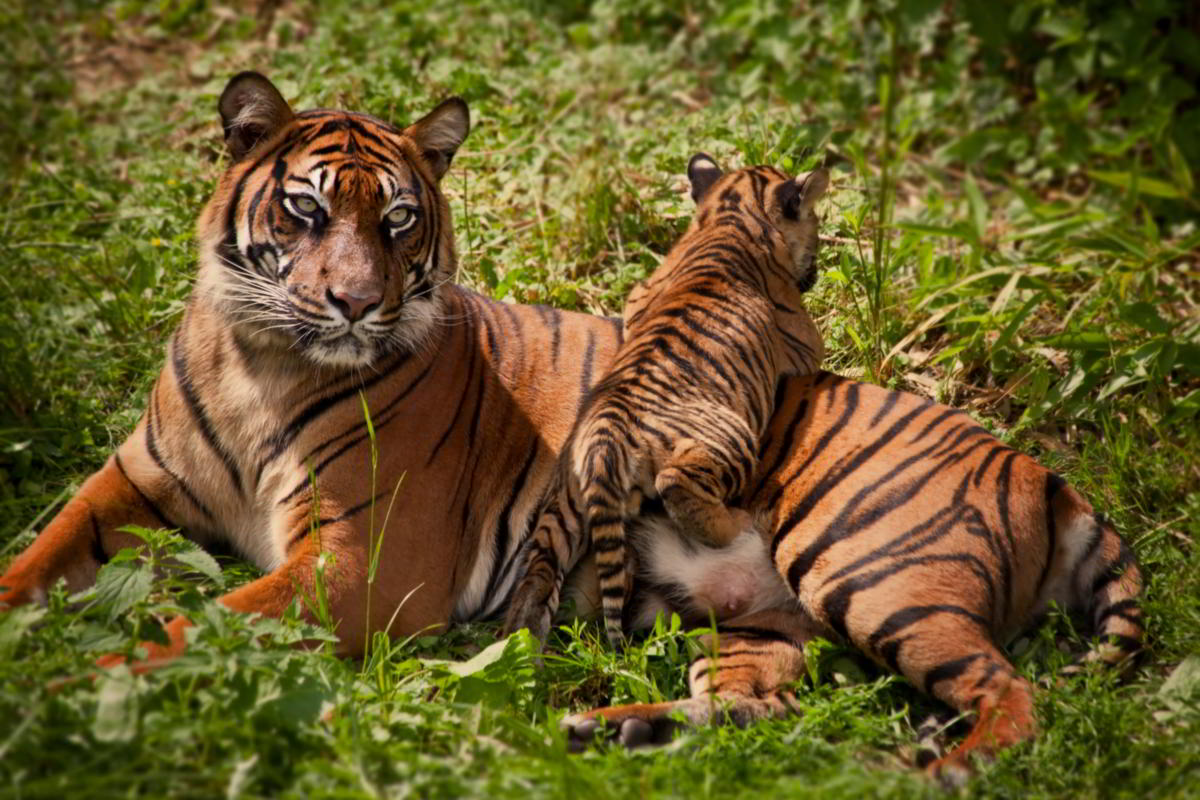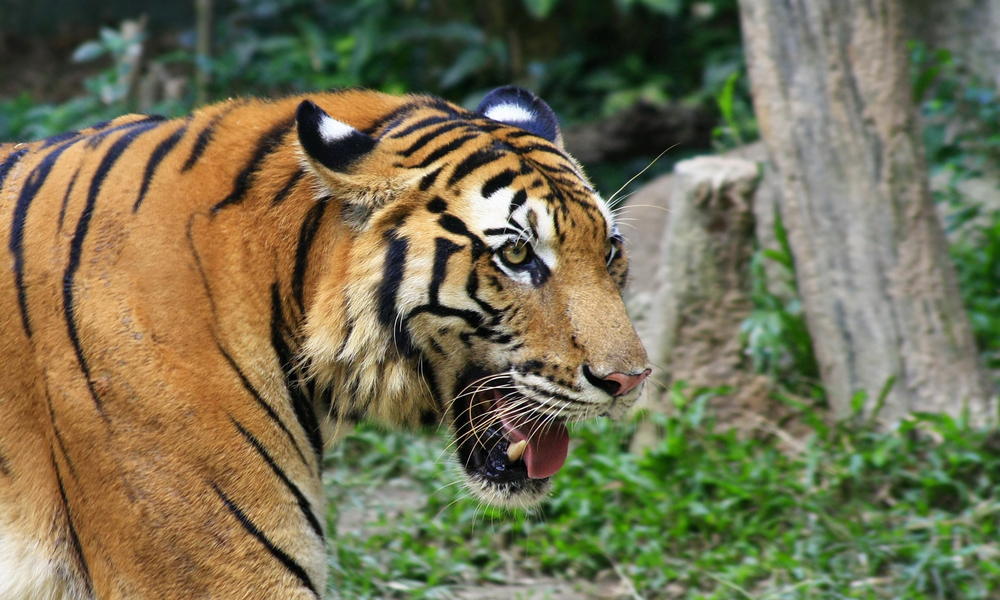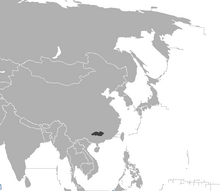CASPIAN TIGER:
Facts about the Caspian Tiger:
Facts about the Caspian Tiger:
Name:
Caspian Tiger; also known as Panthera tigris virgata
Habitat:
Plains of central Asia
Size and Weight:
Up to nine feet long and 500 pounds
Diet:
Meat
Distinguishing Characteristics:
Large size; distinctive stripes; larger males than females
Name:
Caspian Tiger; also known as Panthera tigris virgata
Habitat:
Plains of central Asia
Size and Weight:
Up to nine feet long and 500 pounds
Diet:
Meat
Distinguishing Characteristics:
Large size; distinctive stripes; larger males than females
THE CASPIAN TIGER EXTINCTION:
:max_bytes(150000):strip_icc():format(webp)/caspiantiger-56a295213df78cf77277b860.jpg)
This Caspian Tiger was photographed in the Berlin Zoo in 1899. Historic photo courtesy of Peter Maas
← Original distribution
(in dark grey)
One of three subspecies of Eurasian tiger to go extinct within the last century - the other two are the Bali Tiger and the Javan Tiger--the Caspian Tiger once roamed huge swaths of territory in central Asia, including Iran, Turkey, the Caucasus, and the "-stan" territories bordering Russia (Uzbekhistan, Kazakhstan, etc.). An especially robust member of the Panthera tigris family--the largest males approached 500 pounds--the Caspian Tiger was hunted mercilessly during the late 19th and early 20th centuries, especially by the Russian government, which put a bounty on this beast in a heavy-handed effort to reclaim farmlands bordering the Caspian Sea.
There are a few reasons, besides relentless hunting, why the Caspian Tiger went extinct. First, human civilization encroached mercilessly on the Caspian Tiger's habitat, converting its lands into cotton fields and even looping roads and highways through it fragile habitat. Second, the Caspian Tiger succumbed to the gradual extinction of its favorite prey, wild pigs, which were also hunted by humans, as well as falling prey to various diseases and perishing in floods and forest fires (which grew more frequent with changes in the environment). And third, the Caspian Tiger was already pretty much on the brink, restricted to such a small range of territory, in such dwindling numbers, that virtually any change would have tipped it inexorably toward extinction.
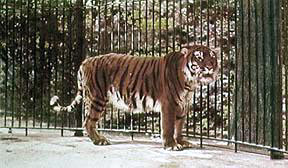
Color-enhanced photo of the captive specimen in the Berlin Zoo, 1899
One of the odd things about the extinction of the Caspian Tiger is that it happened literally while the world was watching: various individuals were hunted died and were documented by naturalists, by the news media, and by the hunters themselves, in the course of the early 20th century. The list makes for depressing reading: Mosul, in what is now the country of Iraq, in 1887; the Caucasus Mountains, in the south of Russia, in 1922; Iran's Golestan Province in 1953 (after which, too late, Iran made hunting the Caspian Tiger illegal); Turkmenistan, a Soviet republic, in 1954; and a small town in Turkey as late as 1970 (although this last sighting is poorly documented).
Although it's widely considered to be an extinct species, there have been numerous, unconfirmed sightings of the Caspian Tiger over the past few decades. More encouragingly, genetic analysis has shown that the Caspian Tiger may have diverged from a population of (still extant) Siberian Tigers as recently as 100 years ago and that these two tiger subspecies may even have been one and the same animal. If this turns out to be the case, it may be possible to resurrect the Caspian Tiger by as simple an expedient as re-introducing the Siberian Tiger to its once-native lands of central Asia, a project that has been announced (but not yet fully implemented) by Russia and Iran, and which falls under the general category of de-extinction.
EXTIRPATION:
The demise of the Caspian tiger began with the Russian colonisation of Turkestan during the late 19th century. Their extirpation was a process intensified by several circumstances:
They were ruthlessly persecuted by large parties of sportsmen and military personnel who hunted wild pigs and tigers with reckless abandon.
The extensive reedbeds of tiger habitat were increasingly converted to cropland for planting cotton and other crops that grew well in the rich silt along rivers, which were used as highways for colonisation of riverine habitat.
The range of wild pigs underwent intense shrinkage between the middle of the 19th century and the 1930s due to thoughtless hunting, natural calamities such as floods and fires, and diseases such as swine fever and foot-and-mouth disease, which caused large and rapid die-offs.
Tigers were already vulnerable due to the restricted nature of their distribution, having been confined to watercourses in large expanses of desert environment.
Until the early 20th century, the regular Russian army was used to clear predators from forests, around settlements, and potential agricultural lands. Until World War I, about 100 tigers were killed in the forests of Amu-Darya and Piandj Rivers each year. High incentives were paid for tiger skins up to 1929. Wild pigs and deer, the prey base of the tigers, were decimated by deforestation and subsistence hunting by the increasing human population along the rivers, supported by the growing agricultural developments. By 1910, cotton plants were estimated to occupy nearly one-fifth of Turkestan's arable land, with about one half located in the Fergana Valley.

Comparative illustration of the stripe patterns on the tails of Caspian (left) and Siberian tigers (right). By kids.kiddle.co
:max_bytes(150000):strip_icc():format(webp)/caspiantiger-56a295213df78cf77277b860.jpg) |
| This Caspian Tiger was photographed in the Berlin Zoo in 1899. Historic photo courtesy of Peter Maas |
← Original distribution
(in dark grey)
One of three subspecies of Eurasian tiger to go extinct within the last century - the other two are the Bali Tiger and the Javan Tiger--the Caspian Tiger once roamed huge swaths of territory in central Asia, including Iran, Turkey, the Caucasus, and the "-stan" territories bordering Russia (Uzbekhistan, Kazakhstan, etc.). An especially robust member of the Panthera tigris family--the largest males approached 500 pounds--the Caspian Tiger was hunted mercilessly during the late 19th and early 20th centuries, especially by the Russian government, which put a bounty on this beast in a heavy-handed effort to reclaim farmlands bordering the Caspian Sea.
There are a few reasons, besides relentless hunting, why the Caspian Tiger went extinct. First, human civilization encroached mercilessly on the Caspian Tiger's habitat, converting its lands into cotton fields and even looping roads and highways through it fragile habitat. Second, the Caspian Tiger succumbed to the gradual extinction of its favorite prey, wild pigs, which were also hunted by humans, as well as falling prey to various diseases and perishing in floods and forest fires (which grew more frequent with changes in the environment). And third, the Caspian Tiger was already pretty much on the brink, restricted to such a small range of territory, in such dwindling numbers, that virtually any change would have tipped it inexorably toward extinction.
 |
| Color-enhanced photo of the captive specimen in the Berlin Zoo, 1899 |
One of the odd things about the extinction of the Caspian Tiger is that it happened literally while the world was watching: various individuals were hunted died and were documented by naturalists, by the news media, and by the hunters themselves, in the course of the early 20th century. The list makes for depressing reading: Mosul, in what is now the country of Iraq, in 1887; the Caucasus Mountains, in the south of Russia, in 1922; Iran's Golestan Province in 1953 (after which, too late, Iran made hunting the Caspian Tiger illegal); Turkmenistan, a Soviet republic, in 1954; and a small town in Turkey as late as 1970 (although this last sighting is poorly documented).
Although it's widely considered to be an extinct species, there have been numerous, unconfirmed sightings of the Caspian Tiger over the past few decades. More encouragingly, genetic analysis has shown that the Caspian Tiger may have diverged from a population of (still extant) Siberian Tigers as recently as 100 years ago and that these two tiger subspecies may even have been one and the same animal. If this turns out to be the case, it may be possible to resurrect the Caspian Tiger by as simple an expedient as re-introducing the Siberian Tiger to its once-native lands of central Asia, a project that has been announced (but not yet fully implemented) by Russia and Iran, and which falls under the general category of de-extinction.
EXTIRPATION:
The demise of the Caspian tiger began with the Russian colonisation of Turkestan during the late 19th century. Their extirpation was a process intensified by several circumstances:
They were ruthlessly persecuted by large parties of sportsmen and military personnel who hunted wild pigs and tigers with reckless abandon.The demise of the Caspian tiger began with the Russian colonisation of Turkestan during the late 19th century. Their extirpation was a process intensified by several circumstances:
The extensive reedbeds of tiger habitat were increasingly converted to cropland for planting cotton and other crops that grew well in the rich silt along rivers, which were used as highways for colonisation of riverine habitat.
The range of wild pigs underwent intense shrinkage between the middle of the 19th century and the 1930s due to thoughtless hunting, natural calamities such as floods and fires, and diseases such as swine fever and foot-and-mouth disease, which caused large and rapid die-offs.
Tigers were already vulnerable due to the restricted nature of their distribution, having been confined to watercourses in large expanses of desert environment.
Until the early 20th century, the regular Russian army was used to clear predators from forests, around settlements, and potential agricultural lands. Until World War I, about 100 tigers were killed in the forests of Amu-Darya and Piandj Rivers each year. High incentives were paid for tiger skins up to 1929. Wild pigs and deer, the prey base of the tigers, were decimated by deforestation and subsistence hunting by the increasing human population along the rivers, supported by the growing agricultural developments. By 1910, cotton plants were estimated to occupy nearly one-fifth of Turkestan's arable land, with about one half located in the Fergana Valley.
 |
| Comparative illustration of the stripe patterns on the tails of Caspian (left) and Siberian tigers (right). By kids.kiddle.co |
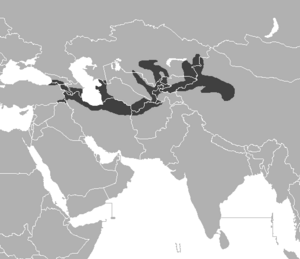

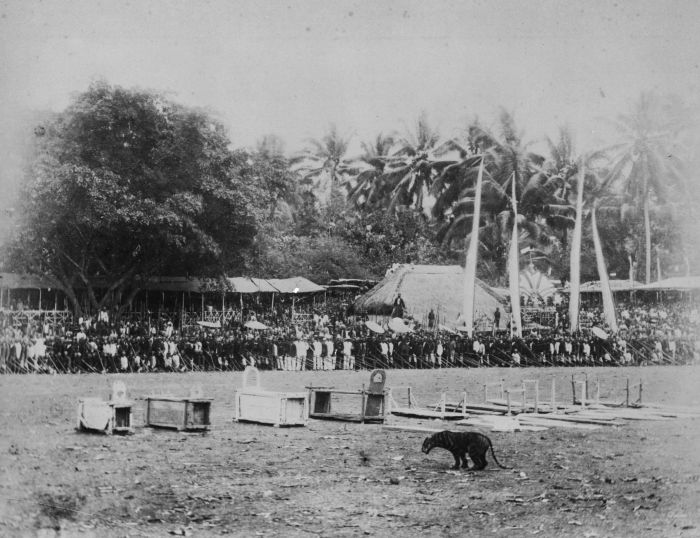

/https://public-media.si-cdn.com/filer/2d/bd/2dbddbbc-29a0-427c-a940-f32d2eabde08/panthera_tigris_sondaica_01.jpg)

/balitigerWC-56a254143df78cf7727479f1.jpg)

